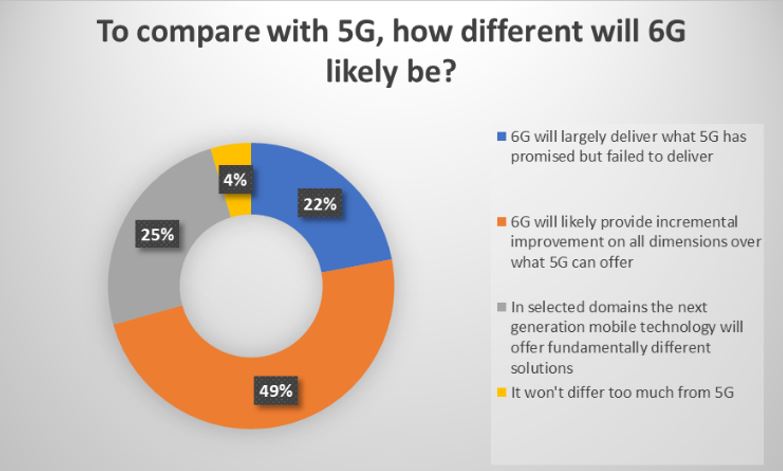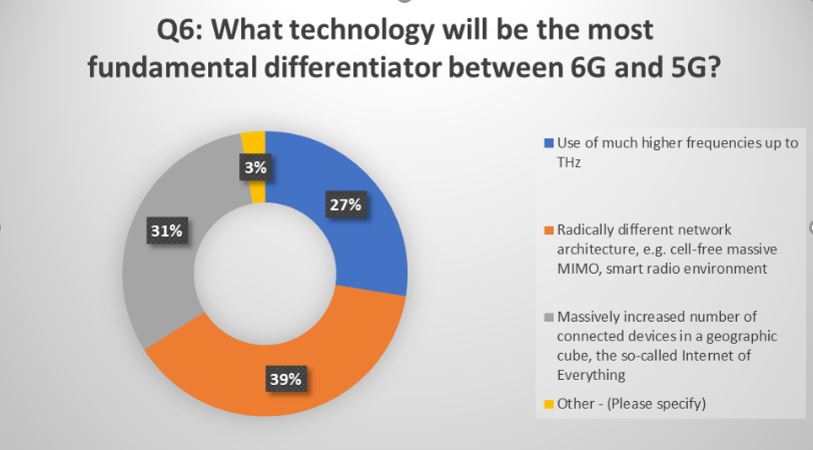
Wireless connectivity has become such an essential element of society that leading industry companies have already begun looking into the sixth generation of mobile networking.
This survey, which included more than 200 telecom industry respondents, many of whom work in engineering, development, and IT management, demonstrates how many experts believe that sixth-generation mobile networking will improve networking capacities, faster speeds, and more connected devices.
About 50 percent of respondents believe that 6G will be more of an evolutionary generation than the one after 5G and that is the most likely scenario. In contrast, almost a quarter (27 percent) believed that 6G would offer fundamentally different answers in certain areas.
According to more than half (51%) of industry experts, emerging technologies will be transformed into new industries, such as human-machine interaction, when the 6G era arrives. As a result, some believe that 6G's true potential is to enhance and alter established sectors like manufacturing, transportation, and the Internet of Things (IoT)
About 44 percent of respondents believe the first commercial 6G service will be available by 2028. Nearly half believe standardization bodies will develop 6G standards in the next 4-5 years or between 2025-2026. According to a third of respondents (39%), the first commercial service would be available by 2030.
Researchers at Queen's University Belfast say ten immediate engineering difficulties must be addressed at the physical layer to accelerate research and development in the 6G ecosystem. mmWave and terahertz (THz) frequency bands, programmable surfaces, and cell-free massive MIMO networks are some ways 6G can address the problems of 5G. So, if you want 6G use cases, you'll need to increase the adaptability of your networks and improve end-to-end connections. You'll also require devices embedded in more places.
Even while the telecom industry is already planning for changes, most of what happens may rely on what enterprises look like in 8-10 years' time Today.
For the time being, 5G is causing a seismic change, as it raises our need for better communications and more extraordinary use cases to improve our lives.


Is 6G going to be our open platform for innovation in the future?
Many companies want to be the first to give something that previous mobile generations couldn't. However, Telecoms.com Intelligence recently conducted a study [1] on 6G expectations. The results show that the growing demand and the rapid transition of cutting-edge technologies have created issues beyond the capabilities of 5G networks.
This survey, which included more than 200 telecom industry respondents, many of whom work in engineering, development, and IT management, demonstrates how many experts believe that sixth-generation mobile networking will improve networking capacities, faster speeds, and more connected devices.
About 50 percent of respondents believe that 6G will be more of an evolutionary generation than the one after 5G and that is the most likely scenario. In contrast, almost a quarter (27 percent) believed that 6G would offer fundamentally different answers in certain areas.
According to more than half (51%) of industry experts, emerging technologies will be transformed into new industries, such as human-machine interaction, when the 6G era arrives. As a result, some believe that 6G's true potential is to enhance and alter established sectors like manufacturing, transportation, and the Internet of Things (IoT)
About 44 percent of respondents believe the first commercial 6G service will be available by 2028. Nearly half believe standardization bodies will develop 6G standards in the next 4-5 years or between 2025-2026. According to a third of respondents (39%), the first commercial service would be available by 2030.
Researchers at Queen's University Belfast say ten immediate engineering difficulties must be addressed at the physical layer to accelerate research and development in the 6G ecosystem. mmWave and terahertz (THz) frequency bands, programmable surfaces, and cell-free massive MIMO networks are some ways 6G can address the problems of 5G. So, if you want 6G use cases, you'll need to increase the adaptability of your networks and improve end-to-end connections. You'll also require devices embedded in more places.
Even while the telecom industry is already planning for changes, most of what happens may rely on what enterprises look like in 8-10 years' time Today.
For the time being, 5G is causing a seismic change, as it raises our need for better communications and more extraordinary use cases to improve our lives.


Is 6G going to be our open platform for innovation in the future?
Read the entire Telecoms.com Intelligence study report to learn more about what telecom industry leaders expect from 6G.
[1] https://telecoms.com/intelligence/charting-the-engineering-route-to-6g/



There is no any comment yet! Be the first!